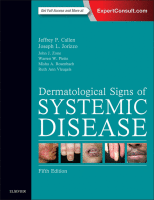Physical Address
304 North Cardinal St.
Dorchester Center, MA 02124

Key Points Autoinflammatory syndromes are characterized by excessive multisystem inflammation from activation of innate pathways rather than the acquired immune system. Autoinflammatory syndromes are mostly rare monogenic disorders that generally first present in childhood. Most of these diseases are, at…

Key Points Rheumatoid arthritis (RA) is a multisystem disorder with many extra-articular manifestations that may affect the skin, including rheumatoid nodules and rheumatoid vasculitis. Rheumatoid nodules are the most characteristic cutaneous manifestation of RA. They, along with other extra-articular manifestations,…

Key Points Psoriasis is common, affecting over 125 million worldwide. Comorbidities include diabetes, hypertension, dyslipidemia, obesity, myocardial infarction, stroke, cardiovascular death, lymphoma, autoimmune disorders, and renal disease. TNF signaling and the IL-23/Th17 pathways are critical in the pathogenesis of psoriasis,…

Key Points Neutrophilic dermatoses encompass a spectrum of diseases marked by cutaneous lesions that on histopathologic examination show intense inflammation composed primarily of mature neutrophils. Behçet’s disease is a neutrophilic dermatosis characterized by an immune-mediated occlusive vasculitis of small, medium,…

Key Points Vasculitic processes may be idiopathic or associated with infections, drugs, malignancies, or connective tissue diseases. Drugs and infections are the most common underlying etiologies in adults with cutaneous vasculitis (CV). IgA vasculitis (Henoch-Schönlein purpura) is the most frequent…

Key Points The range of conditions presenting as “hard skin” is broad, including those diseases that cause cutaneous sclerosis (increased connective tissue with normal or decreased fibroblasts) and those that cause cutaneous fibrosis (increased connective tissue and increased fibroblasts). The…

Key Points Classic dermatomyositis involves a proximal inflammatory myopathy with a characteristic cutaneous eruption. In patients with clinically amyopathic dermatomyositis, skin disease is the prominent feature. Pathognomonic cutaneous findings of dermatomyositis include the heliotrope eruption and Gottron’s papules. In dermatomyositis,…

Key Points Lupus erythematosus is a multisystem disorder that frequently has cutaneous involvement Lupus-specific skin disease can be characterized as acute, subacute, or chronic based on clinical and laboratory features Other nonspecific cutaneous changes such as cutaneous vasculitis and Raynaud’s…